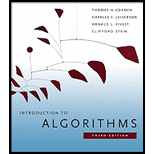
a
To prove the problem of determining the minimum number of bins required is NP-HARD.
a
Explanation of Solution
Suppose
Note that
So, the answer of derived bin-packing problem can-not be less than 2 . First assume that the answer to the given instance of sub set -sum problem is “yes”.
Now, there is
Now
b
To argue that the optimal number of bins required is at least
b
Explanation of Solution
Consider the packing ofn objects with sizes
Let
Therefore,
Since bis an integer number,
c
To argue that the first-fit heuristic leaves at most one bin less than half full.
c
Explanation of Solution
The first- fit heuristic places each object in the first available bin. Suppose by contradiction that two bins
d
To prove that the number of bins used by the first-fit heuristic is never more than
d
Explanation of Solution
Consider a bin- packing solution provided by the first-fit HEURISTIC.
Using similar notation as in (b) (let
It can be assumed without loss of generality that
e
To prove an approximation ratio of 2 for the first-fit heuristic.
e
Explanation of Solution
Letb be the number of the bins used the first-fit HEURISTIC and let
e
To give an efficient implementation of the first-fit heuristic, and analyze its running time.
e
Explanation of Solution
1.
2. initialize data structures
3. fori = 1 to ndo
4. letjbe the first bin that can fit objecti with size
5. ifjexists then
6. inserti at the list (list
7.update data structures
8.else
9.
10. insertiat the list
11.update data structures II
12.endif
13. endfor
Each of the above steps can be done in
Want to see more full solutions like this?
Chapter 35 Solutions
Introduction to Algorithms
- Please solve and answer the questions correctly please. Thank you!!arrow_forwardConsidering the TM example of binary sum ( see attached)do the step-by-step of execution for the binary numbers 1101 and 11. Feel free to use the Formal Language Editor Tool to execute it; Write it down the current state of the tape (including the head position) and indicate the current state of the TM at each step.arrow_forwardI need help on inculding additonal code where I can can do the opposite code of MatLab, where the function of t that I enter becomes the result of F(t), in other words, turning the time-domain f(t) into the frequency-domain function F(s):arrow_forward
 Operations Research : Applications and AlgorithmsComputer ScienceISBN:9780534380588Author:Wayne L. WinstonPublisher:Brooks Cole
Operations Research : Applications and AlgorithmsComputer ScienceISBN:9780534380588Author:Wayne L. WinstonPublisher:Brooks Cole C++ Programming: From Problem Analysis to Program...Computer ScienceISBN:9781337102087Author:D. S. MalikPublisher:Cengage Learning
C++ Programming: From Problem Analysis to Program...Computer ScienceISBN:9781337102087Author:D. S. MalikPublisher:Cengage Learning C++ for Engineers and ScientistsComputer ScienceISBN:9781133187844Author:Bronson, Gary J.Publisher:Course Technology Ptr
C++ for Engineers and ScientistsComputer ScienceISBN:9781133187844Author:Bronson, Gary J.Publisher:Course Technology Ptr


